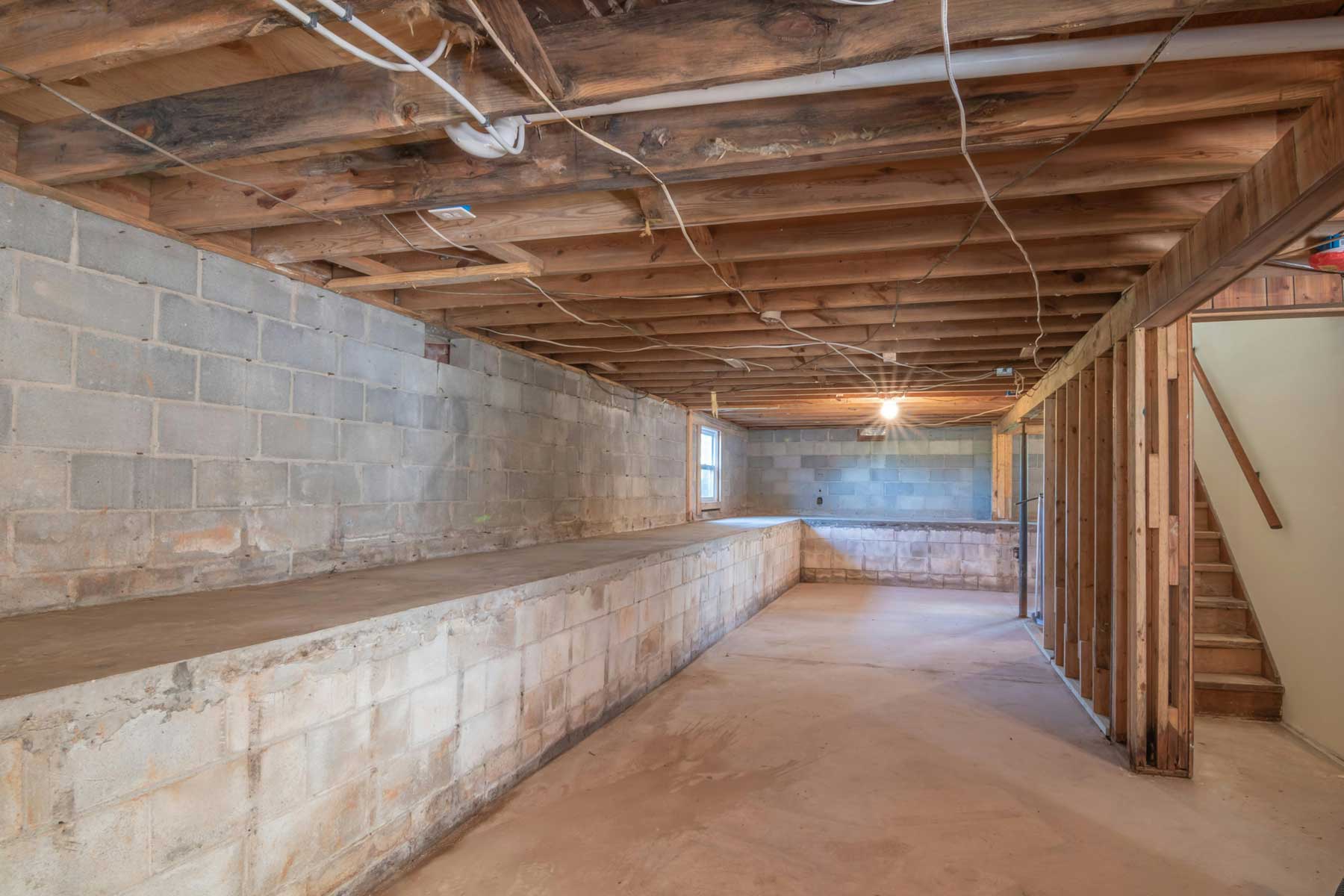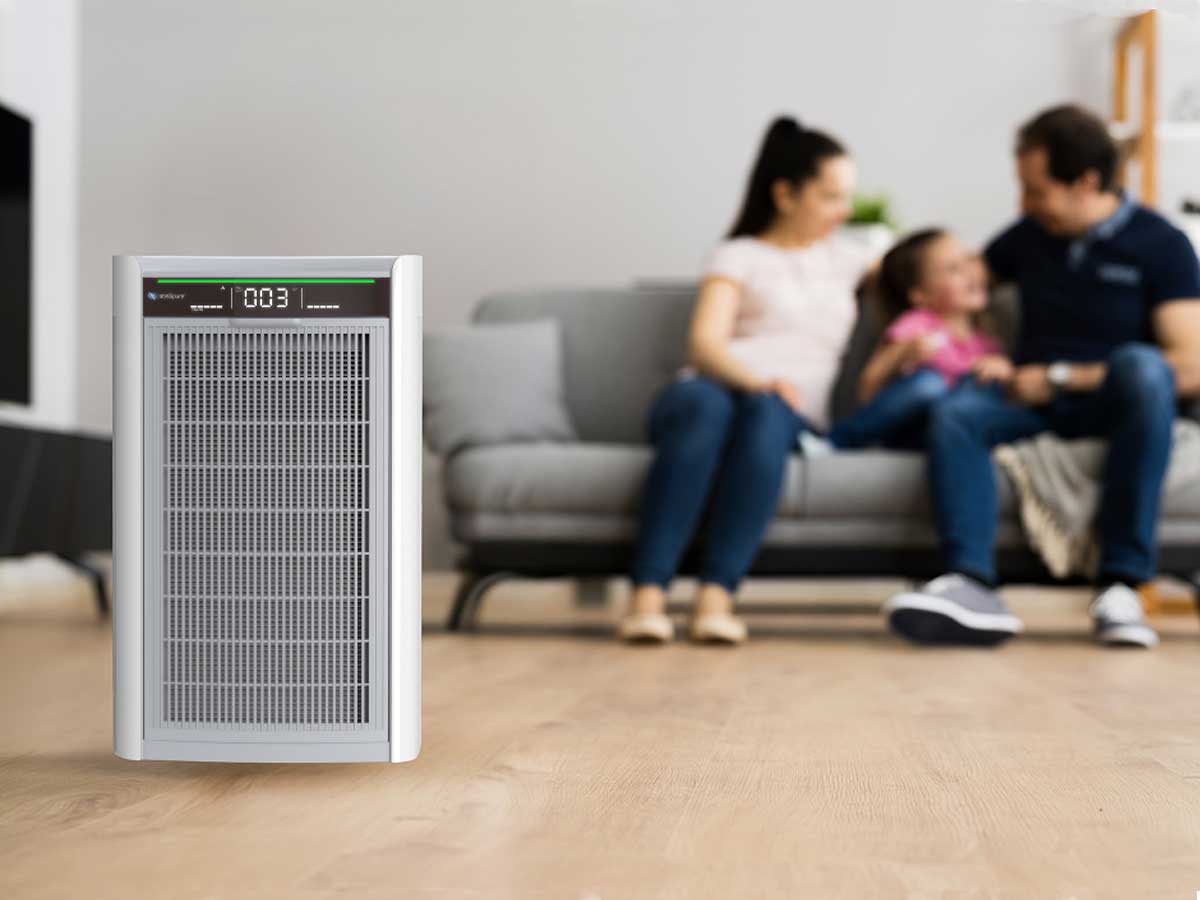
Summary
- Musty odors are caused by mold and mildew thriving in damp, poorly ventilated areas, releasing VOCs that create the smell.
- Persistent musty smells signal hidden moisture or mold problems that can impact health, including asthma, allergies, and respiratory irritation.
- Effective odor removal requires addressing root causes with moisture control, ventilation, and deep cleaning—not just masking odors.
- Air purifiers with HEPA and activated carbon filters help by capturing mold spores and neutralizing odor-causing chemicals.
- Long-term solutions include dehumidifiers, HVAC maintenance, and consistent home upkeep to prevent moisture buildup and mold growth.
Are you tired of feeling like you live in a well-lit root cellar? Does a musty odor seem to follow from the basement on laundry day and just stick with you? If musty odors are haunting you then we have answers. We’ll cover how to eliminate that wet basement smell from not only your living spaces but also your clothes. If you’ve heard about health issues linked to mold, you are right to be concerned about the tell-tale mold smell. Here’s how to get rid of musty smells practically and for the future.
What Causes Musty Smells in Your House
When it comes to earthy, musty odors the most common culprits are excess moisture and poor ventilation. Often water damage occurs in spaces under floors and behind walls where it can’t be seen until it is too late. Whenever humidity levels are allowed to stay high for extended periods of time mold and mildew thrive. Conditions are especially ripe in closed off rooms, basements or storage areas where stagnant air sits. Simple daily activities like bathing, cooking, washing laundry, even just breathing add moisture to the air that can build up over time.
Understanding Mold and Mildew
Differences
Mold and mildew are both a type of fungi that grow wherever there is enough moisture to sustain them. As they grow they release volatile organic compounds (VOCs) linked to their distinctive stale, musty odor. The larger the colony, the stronger the odor. Mold usually appears fuzzy, slimy or raised and can be a wide range of colors. It grows readily in persistently damp areas like basements, behind walls, inside drywall or even on wood where it penetrates deeply into the material. Mildew typically appears as a flat or powdery substance on a damp surface. It grows often on bathroom walls or any other place where warm, humid air occurs often. As mold and mildew consume organic matter they release their tell-tale smell. Mildew only grows on the surface and can be easily wiped away. Mold unfortunately burrows deeply into materials and requires more complicated removal techniques.
Is Musty Smell Unhealthy for Your Family?
Since musty smells are typically caused by mold and mildew, there can be negative respiratory health effects. Coughing, sneezing, runny nose, sore throat, stuffy nose, wheezing and eye irritation can all occur due to mold exposure. Those with asthma or chronic obstructive pulmonary disease (COPD) may experience worsening symptoms. Children exposed early on have a higher risk of developing respiratory issues. In severe cases those with compromised immune systems are at serious risk of fungal lung infections. When a musty odor persists, there is a serious air quality problem. In order to protect the health of yourself and your loved ones, do not ignore the musty odor signs of mold and mildew by merely covering it up with air freshener. You must get to the root of the problem.
Why You Keep Smelling Musty Odors
If musty smells seem to stick around, you may have a recurring moisture problem. Not every water leak presents itself like the ones in comedy movies spraying the star in the face. Often water problems slowly seep in through a leaky roof, a cracked foundation wall, a leaky pipe dripping into a crawlspace, or a clogged HVAC condensation line that fills the pan with ice cold water. Seasons can also play a part in moisture problems. Spring rains bring warm temperatures and heavy humidity for weeks at a time. In the winter condensation in tightly sealed homes collects on cold surfaces and gets trapped leading to mold growth. Once musty smells soak into materials they can be hard to get out. Often the way materials are layered (like carpet over a wood subfloor) means lots of hidden spaces where mold can hide away from the surface. That’s why cleaning the top layer only scratches the surface of mold removal, for true mold remediation the source of the mold must be chased all the way down to the root of the problem.
Do Musty Smells Indicate Mold Growth?
If you have a musty smell that seems to cling to certain areas even after you cleaned everything, you likely have a mold problem. This is especially true in areas where moisture is an issue. Signs like water stains, paint bubbling, discoloration, oddly damp spots under rugs or behind furniture or an increase in allergy symptoms all point to a mold problem. Surface problems with mildew typically occur on smooth materials that get wet often and are easier to solve. Mold on the other hand often occurs on porous materials where it can penetrate deep below the surface. Cleaning the surface mold leaves the root-like structures intact inside the material where it can continue to grow.
Even if you don’t see visual signs of mold growth the problem could be hidden deep within walls or floors leading to the tell-tale persistent musty smell. If you think there is a mold problem but you can’t find it, calling in a professional is a wise choice. A professional will do a thorough inspection of the building likely using a moisture detector, air sampling, and surface testing to determine if mold is present.
Getting Rid of Musty Smells From Your Clothes
If musty odors have crept into your closet here are a few ways to get them out.
Washing Machine and Laundry Room Solutions
Start by making sure your washing machine isn’t the source of your mold smells. If you have a front load washer, clean the door gasket with a mixture of equal parts water and white vinegar, making sure to get into all of the folds. Run an empty hot water cycle with two cups of white vinegar to help dissolve any buildup. Use a mild bleach solution on any stubborn mold stains. After the cycle is done, wipe down the entire inside of the washer and leave the door open for it to dry completely.
Once the washer is clean you can move on to your clothes. Do not just reach for the bleach, which can damage some fabrics. Look for detergents that use enzymes to break down odor causing stains. Another popular detergent choice includes oxygen-based ingredients that break down odors. Make sure to only use the correct amount of detergent for your needs, as excess detergent can leave residue that actually holds odors. You can also add a half cup of white vinegar to the fabric softener dispenser when odors need to be put back in line. A half cup of baking soda added right on top of the dirty laundry before washing will also help remove odors. Just don’t use white vinegar with baking soda at the same time, as they will cancel each other out.
Once clothes are clean make sure they are completely dry before putting them away. If you have a clothes line hang your clothes out in the sun for a few hours to really help clear any remaining odors. When it comes time to put your clothes away make sure the space has good airflow. Use breathable baskets and hang clothes with enough space to allow air to circulate. For long term storage use fabric garment bags or mesh organizers instead of sealed totes or plastic bags. Clean your closet regularly to prevent odors from building up. Leave the closet door open or switch to a louvered door to allow air to flow freely.
Treating Severely Affected Clothing
If smells are really embedded you can try pre-treating them a few different ways. Fully submerge clothes overnight in a mix of equal parts white vinegar with water, then rinse well and wash as usual. You can sprinkle baking soda directly on the odor stain and let it sit overnight, then wash normally. Hanging clothes outside in the sunlight is not only an eco-friendly drying method but it is also a natural way to eliminate odors. Ultraviolet light breaks down the DNA of odor causing bacteria helping to freshen clothes without chemicals. If smells refuse to move along it might be time to seek professional help, especially if the item is delicate or complex. If you’ve exhausted all options it might be time to just replace the item of clothing and move on.
Preventing Musty Smells in Closets and Storage
Proper airflow is key to keeping musty smells out of your closet.. Leave your closet door open occasionally to allow airflow and flush out stale air. Don’t cram clothes in the closet, leave space where air can move around and through them freely. Consider using moisture absorbing packets to reduce humidity. Make sure there are no water leaks near the closet that could add to humidity. Place a box of baking soda in the closet to capture odors. Cedar wood blocks not only keep moths away but help freshen your closet. When seasons change and it is time to store clothes, remember that air also needs to circulate wherever you store them. While vacuum bags are great for saving space, they can also trap stale air. Make sure to vacuum and dust your closet often to remove any odor carrying particles. Rotate clothing so they can have access to fresh air. Make sure to replace any odor absorbing products on a routine basis so they can keep working as expected.
How to Get Rid of Musty Smells From Your Home
If your home is the source of the musty odor, you need to act.
Room-by-Room Elimination Strategies
Here’s how to deal with musty odors room-by-room in your home.
- Basement or crawl space - Use a dehumidifier and improve ventilation to reduce humidity. Waterproof the foundation and install a vapor barrier. Keep the space free of clutter so air can circulate freely.
- Bathroom - Always use an exhaust fan when bathing and allow it to run until humidity has been reduced. Wipe down wet surfaces and leave the door open so everything can dry. Hang up damp towels so they can dry.
- Bedroom - Use a ceiling fan or occasionally open windows for air circulation. Wash bedding regularly so odors don’t linger. Consider using a small dehumidifier in humid areas.
- Living room - Vacuum regularly to remove dust and mold spores. Open windows on nice days for fresh air. Changes HVAC filters on a regular basis for proper whole-house airflow.
- Kitchen - Use the ventilation hood whenever cooking to remove both odors and moisture. Wipe down counters and floors to keep moisture from standing.
- Attic - Make sure it is properly insulated and vented for airflow. Install a moisture barrier if necessary and inspect it regularly. Check for signs of roof leaks or moisture damage.
Deep Cleaning Methods That Work
When it comes to getting rid of musty smells there are a few approaches. Undiluted vinegar in a spray bottle can kill most mold and mildew types, simply saturate the area and let it sit for an hour before wiping clean. For carpets and rugs the heat from steam cleaning can kill mold and mold spores while using less water than shampooing. Walls and ceilings should be gently cleaned with diluted bleach to kill mold, then coated with mold- resistant primer and repainted. Before attempting to clean floors, research your floor material to prevent accidental damage by using the wrong product.
Preventing Musty Odors in Your Basement
Keeping water out is the most important step of stopping musty smells. Make sure water drains away from your foundation. Extend drain spouts into the yard and make sure gutters are flowing correctly. Consider installing a french drain if there is standing water near your foundation. Waterproof the outside of the foundation if possible, but an inside waterproofing coating is better than nothing. Place a dehumidifier in the middle of the basement where it can process as much wet air as possible. A simple shop fan can help circulate air and prevent stale pockets from forming where mold can thrive. If you need your basement for storage use shelving that gets things up off the floor and away from the walls so air can circulate. Use plastic totes that are resistant to moisture. Make sure to check your basement after any heavy rains or at least once a week to catch any water intrusions before they become a problem.
How Air Purifiers Help Eliminate Musty Odors
An air purifier can be a powerful ally in taking back control of your home from a musty invader.
Technology That Targets Musty Smell Sources
Covering up smells isn’t a long term solution, you have to remove them from the environment. An air purifier with a HEPA filter can capture mold spores and other odor causing particles, locking them away in the filter for later disposal. If the air purifier has an activated charcoal filter it can adsorb the actual chemicals that cause odors, also locking them away. By continuously filtering the air the number of airborne contaminants is reduced, leaving fewer potential odor sources. It also prevents mold spores from spreading to new areas. Placing an air purifier in a room where musty odors are a problem also keeps the smell from spreading to other areas of the house.
Choosing and Using Air Purifiers for Musty Smells
In order for an air purifier to be effective against musty smells it needs to have both a HEPA filter and an activated charcoal filter. Removing the ability for mold to spread while also stopping the odors takes a two-pronged approach. Place the air purifier in the middle of the room, or if the source of the mold has been located place the air purifier nearby. Keep in mind that each air purifier has a stated clean air delivery rate (CADR) which is a measurement of how much air volume it can clean per minute. You need an air purifier that has the capacity to clean all of the air in the room at least four times per hour. Read the air purifier owner’s manual and follow the filter replacement schedule exactly to ensure maximum air cleaning efficiency.
Safety When Cleaning Mold and Mildew
Mold can have serious health impacts if it isn’t handled carefully.
Protective Equipment You Need
Cleaning up mold is a nasty business. At minimum you will need the following:
- N95 respirator
- Non-vented goggles (NOT just safety glasses)
- Nitrile gloves
- Disposable painting suit
- Waterproof boots
These will keep you safe from contacting mold spores that will be swirling in the air as you work. Do not skip the eye or respiratory protection, as mold spores can cause a number of health issues. Next you need to vent the air in the work area outside. Seal up all vents and doors in the room while placing a fan in the window blowing outward. This will pull air from the rest of the house and prevent mold spores from spreading outside of the affected area.
Safe Cleaning Methods and Products
You can kill mold using natural products like white vinegar, baking soda, tea tree oil, hydrogen peroxide or lemon juice. While the usual go-to product is bleach, its noxious smell and caustic nature make it unpleasant. Try natural methods first before resorting to harsher chemicals. Place all materials used for cleaning (paper towels, rags, debris) in plastic bags and tape them shut. The bags can then be placed in your regular trash can for pickup. Make sure to keep the ventilation going for at least 24 hours after cleanup is done to clear any lingering mold spores or moisture.
When Musty Smells Require Professional Help
Sometimes a mold problem goes beyond what a DIYer can handle. When mold gets a few years head start, it can be amazing how far it can go. If you see things like crumbling wood, crumbling sheetrock, large water stains or water that just won’t go away it is time to call in the professionals. If you experience a cough that won't go away, wheezing, shortness of breath, tightness in the chest, runny nose, brain fog, chronic fatigue or just don’t feel right you may be exposed to mold. In limited cases your home insurance may cover the cost of mold remediation, but it is not a common part of most coverage. Keep in mind that while DIY mold cleanup may be cheaper, it may not get all of the mold and you could end up with the same problem again.
Creating Long-term Solutions for Fresh Indoor Air
If you want fresh air that lasts you need a plan.
Moisture Control Systems
Mold and mildew need moisture to grow, which is why you need to keep indoor moisture levels under control. A portable dehumidifier is great, but only works in a localized area. To really keep your home dry you need a whole-home dehumidifier integrated into your HVAC system. Your HVAC system may already have a dehumidifier setting, so make sure it is enabled. Check your HVAC ducting for air leaks so outside air doesn’t get circulated. Have your HVAC system serviced once a year so it is working at peak performance. For moisture-prone areas (kitchen, bathroom, laundry room) use a ventilation fan that is vented outside so moist air is removed. Make sure your home is well insulated and sealed against air leaks. Many smart thermostats can also monitor indoor humidity levels, but it is also worth investing in standalone moisture meters for a basement or crawlspace.
Regular Maintenance Routines
Walk around your entire home once a week looking for signs of mold, moisture damage or water intrusion. Once a month do a good deep cleaning of your living spaces to prevent odors from building up. Every three months clean the basement or check the crawlspace. Remove any clutter that might give moist air a place to settle. By making the habits part of your normal routine, you will be able to spot and stop mold before it can take hold.
Enjoying Fresh, Clean Air Throughout Your Home
Knowing how to get rid of any musty odors that trouble your home can greatly help you enjoy your indoor time. You can also take control of your indoor air quality with an Intellipure air purifier and breathe easy knowing you are doing something positive for your health. By fixing the current musty odor problem and working to prevent it from happening in the future you are well on your way to a fresh home. It’s easy to get started today, so don’t put up with that musty smell any longer!



 What Causes Poor AQI and How to Protect Your Family
What Causes Poor AQI and How to Protect Your Family




